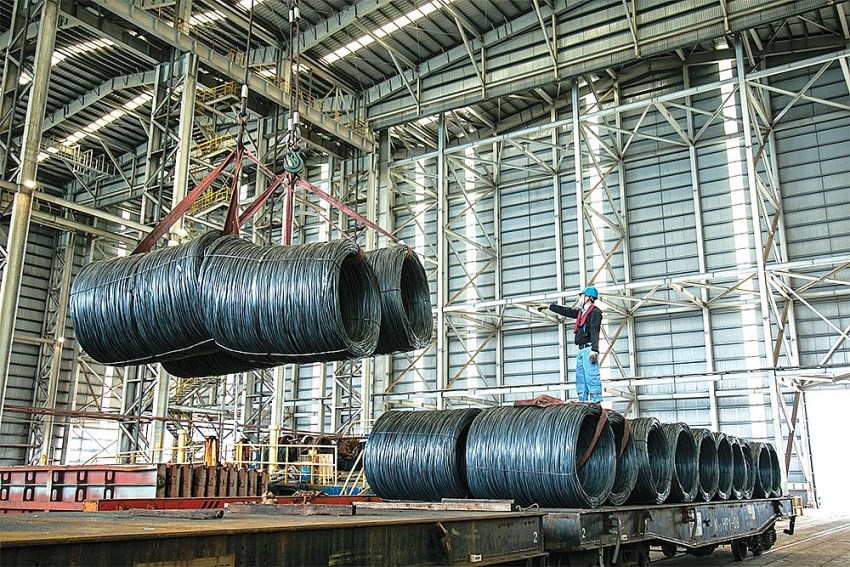Domestic steel demand expected to rebound amid warming real estate market
Domestic steel demand is anticipated to rise this year due to the civil construction recovery and the positive impacts of the global steel market.
16/04/2024 10:59
According to the Vietnam Steel Association, the steel consumption in the domestic market this year is expected to increase by 6.4 per cent compared to 2023, reaching 21.6 million tonnes. Specifically, growth in steel consumption for construction could reach up to 8 per cent.
In early April, the Ministry of Industry and Trade published its development plan for Vietnam's steel industry. Specifically, construction steel has met domestic consumption needs, while hot-rolled and cold-rolled steel sheets have partially met demand.
Construction steel is expected to be the highlight of the steel industry's recovery. Civil construction accounts for 66 per cent of construction steel demand, while public investment makes up 14 per cent. Both sectors have been showing signs of a recovery since late 2023, and consumption in the last two months of the year increased by 30 per cent compared to previous months.
 Domestic steel demand is expected to rebound amidst the warming real estate market
Domestic steel demand is expected to rebound amidst the warming real estate market
Specifically, the real estate market has shown signs of a recovery, especially in the apartment segment, with projects launched in the fourth quarter of last year such as Privia, Akari, and Glory Heights achieving high absorption rates of over 65 per cent. Investor sentiment has become more optimistic due to rising market liquidity and easing financial pressure amid low interest rates.
Phan Ho Chau Nam, deputy general director of Nhan Luat Investment and Steel Trading Holding Corporation, told VIR that, "Based on the positive signals observed in the commercial residential real estate segment in the third quarter of 2023, I anticipate that this trend will continue into 2024. The government has implemented numerous policies to facilitate real estate activities, coupled with tighter control over legal issues in the real estate sector. These efforts have contributed to improving buyer confidence, as evidenced by the resurgence in demand since the third quarter of last year, with the transaction rate for residential properties reaching approximately 30 per cent."
Furthermore, recent amendments to the Land Law and Law on Real Estate Business have contributed to resolving legal obstacles for the real estate market, especially those related to land valuation, compensation, and site clearance. This has helped accelerate project implementation schedules, providing a supply source for the market.
According to MBS Research's forecasts, this year, the supply of apartments in Hanoi and Ho Chi Minh City is expected to increase by 30 per cent and 20 per cent, respectively, compared to 2023, thanks to optimistic investor sentiment and the continued stability of apartment prices. The growth in supply will positively impact the demand for construction steel, as the real estate sector accounts for about 35 per cent of total steel demand in Vietnam.
Meanwhile, public investment disbursement this year, according to the government's plan, is expected to increase by 12 per cent compared to 2023, reaching about $26.58 billion. The government is currently intensifying the construction of transportation infrastructure to serve economic development.
Key projects such as the North-South Expressway and Long Thanh International Airport are expected to be completed ahead of schedule in the 2025-2028 period. Growth in infrastructure construction is expected to contribute positively to the steel industry's recovery.
Recently, in its Short Range Outlook for 2024 and 2025, Worldsteel forecast that global steel demand would rebound by 1.7 per cent this year to 1.79 billion tonnes and increase by 1.2 per cent in 2025 to 1.82 billion tonnes. In its previous forecast, Worldsteel estimated a 1.9 per cent increase in steel demand in 2024 to 1.85 billion tonnes.
Worldsteel believes that global steel demand is showing early signs of stabilisation along a positive trajectory in 2024 and 2025 after two years of negative trends. In developed economies, the steel demand is expected to increase by 1.3 per cent this year and by 2.7 per cent in 2025. Meanwhile, the rapid steel demand growth is expected in developing economies, especially in the Middle East and North Africa (MENA) and ASEAN regions.
The latest report from the European Steel Association (Eurofer) shows that steel consumption in the EU decreased by 5.2 per cent in 2023, but imports of hot-rolled coil from Vietnam remained active due to a shortage of supply from traditional partners such as Russia, Ukraine, Turkey, and the United States.
In 2024, steel consumption in the EU is expected to grow by 7.6 per cent compared to 2023, reaching 142 million tonnes, thanks to sectors with high steel consumption rates such as construction (35 per cent) and automobile manufacturing (18 per cent) recovering as monetary policies tighten. This opens up bright prospects for Vietnam's steel production and exports.
By Hazy Tran (http://vir.com.vn)








